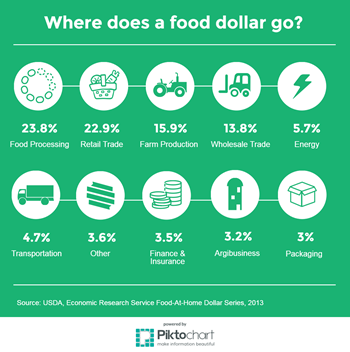By Andrew Harig, Senior Director, Sustainability, Tax & Trade, Food Marketing Institute
 We’re in the midst of one of the longest periods of food price deflation in more than 50 years. USDA reports that the consumer price index has been negative on a year-over-year basis since December 2015, causing severe pressure on same-store sales growth. Retail beef prices have declined in some areas by nearly 8 percent, with pork and poultry on a similar (but slightly less steep) downward trend. USDA predicts we could see up to a 19 percent decline in the CPI for eggs in 2016, and the dairy sector is in dire enough straits that USDA Secretary Tom Vilsack has authorized two rounds of government purchases of surplus cheese. It doesn’t look like this trend is likely to let up in the near future.
We’re in the midst of one of the longest periods of food price deflation in more than 50 years. USDA reports that the consumer price index has been negative on a year-over-year basis since December 2015, causing severe pressure on same-store sales growth. Retail beef prices have declined in some areas by nearly 8 percent, with pork and poultry on a similar (but slightly less steep) downward trend. USDA predicts we could see up to a 19 percent decline in the CPI for eggs in 2016, and the dairy sector is in dire enough straits that USDA Secretary Tom Vilsack has authorized two rounds of government purchases of surplus cheese. It doesn’t look like this trend is likely to let up in the near future.
This certainly is not the first time that the industry has had to face declining food prices, but an interesting plot twist this time around is that this deflationary period is taking place during an economic recovery, not during a recession. This is creating some unique winners and losers across the supply chain.
Winner – Consumers
The biggest winners are consumers, who are experiencing lower prices on a host of products. There have been stories around the country of eggs selling for a dollar a dozen and other deals that seem too good to be true.
Winner – Retailers That Can Work With Consumers to Tell a “Savings Story”
Retailers are finding that they need to be aggressive in working with consumers to help them take advantage of price savings. Retailers who can tell a strong savings story with their customers will clearly emerge from this deflationary period stronger.
Loser – Retail Margins
This round of deflation has its roots in farm country, but farm production only accounts for about 15.9 percent of the average food dollar, and this number decreases as the role of food processing in a finished food increases (see infographic).
Operating a grocery business is vastly different than it was a decade ago with an onslaught of new competitive channels, a cantankerous regulatory environment and the fact that food shopping has become a team sport among households, making it more difficult to pinpoint your customers. Some retailers are pushing prices even lower as a means to drive traffic into their stores. The end result is that already tight margins are being decimated.
Loser – Farm Country
Even as retailers struggle to address the impact of deflation on their margins and the industry as a whole, they cannot afford to ignore the longer term effects on farm country. Whenever this period of deflation comes to an end, the supply chain is likely to look different than when it started.
Learn more about the impact of food price deflation on the grocery industry by watching this recent webinar hosted by FMI and The Food Institute with the U.S. Department of Agriculture Economic Research Service, John Dunham and Associates, and SpartanNash. Access this members-only webinar at www.fmi.org/MemberOnlyWebinars.


 Industry Topics address your specific area of expertise with resources, reports, events and more.
Industry Topics address your specific area of expertise with resources, reports, events and more.
 Our Research covers consumer behavior and retail operation benchmarks so you can make informed business decisions.
Our Research covers consumer behavior and retail operation benchmarks so you can make informed business decisions.
 Events and Education including online and in-person help you advance your food retail career.
Events and Education including online and in-person help you advance your food retail career.
 Food Safety training, resources and guidance that help you create a company food safety culture.
Food Safety training, resources and guidance that help you create a company food safety culture.
 Government Affairs work — federal and state — on the latest food industry policy, regulatory and legislative issues.
Government Affairs work — federal and state — on the latest food industry policy, regulatory and legislative issues.
 Get Involved. From industry awards to newsletters and committees, these resources help you take advantage of your membership.
Get Involved. From industry awards to newsletters and committees, these resources help you take advantage of your membership.
 Best practices, guidance documents, infographics, signage and more for the food industry on the COVID-19 pandemic.
Best practices, guidance documents, infographics, signage and more for the food industry on the COVID-19 pandemic.
